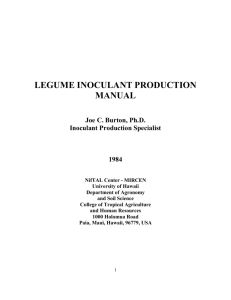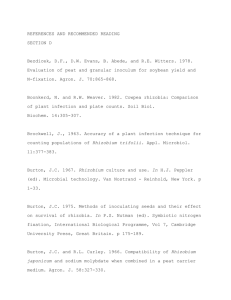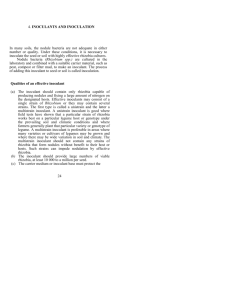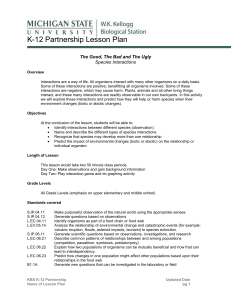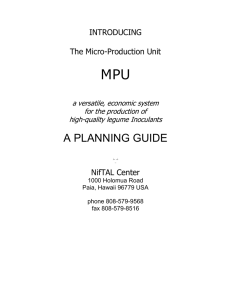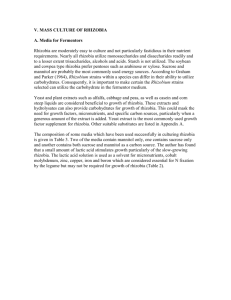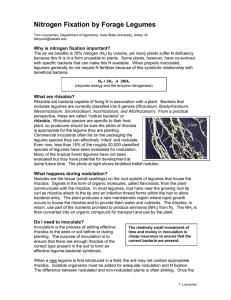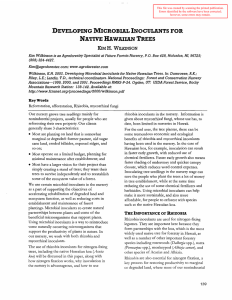Inoculation Technology
advertisement
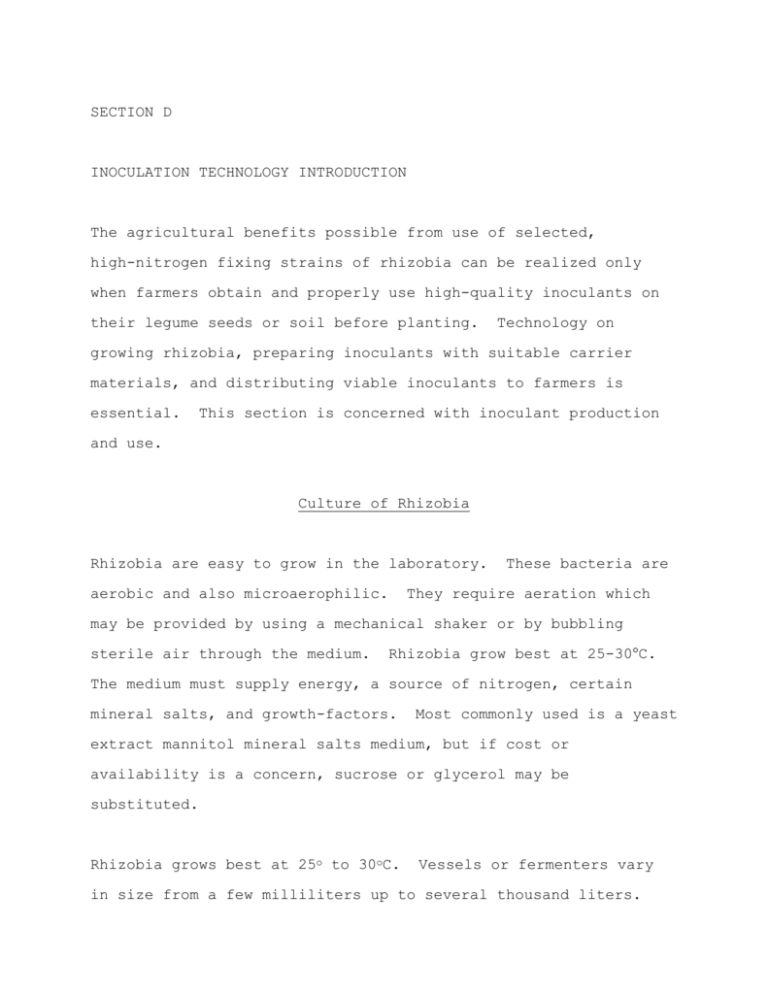
SECTION D INOCULATION TECHNOLOGY INTRODUCTION The agricultural benefits possible from use of selected, high-nitrogen fixing strains of rhizobia can be realized only when farmers obtain and properly use high-quality inoculants on their legume seeds or soil before planting. Technology on growing rhizobia, preparing inoculants with suitable carrier materials, and distributing viable inoculants to farmers is essential. This section is concerned with inoculant production and use. Culture of Rhizobia Rhizobia are easy to grow in the laboratory. aerobic and also microaerophilic. These bacteria are They require aeration which may be provided by using a mechanical shaker or by bubbling sterile air through the medium. Rhizobia grow best at 25-30C. The medium must supply energy, a source of nitrogen, certain mineral salts, and growth-factors. Most commonly used is a yeast extract mannitol mineral salts medium, but if cost or availability is a concern, sucrose or glycerol may be substituted. Rhizobia grows best at 25o to 30oC. Vessels or fermenters vary in size from a few milliliters up to several thousand liters. Incubation time required will vary with size of seed or starter inoculum. Large inocula decrease the incubation time needed to attain the 5 X 108 to 1 X 109 rhizobial cells per milliliter considered necessary, particularly when using a non-sterile carrier material. The broth culture should be checked frequently for purity and any abrupt change in pH which indicates contamination. Prior to incorporation with the carrier material (peat, coal, etc.) the culture should be checked serologically (agglutination, FA etc.) with its homologous antiserum. Incorporation into Carrier The properties of a good carrier material are: No toxicity to rhizobia, good moisture absorption capacity (for example not more than 15% moisture in most peats prior to addition of culture), suitable pH (6.5-7.0), fine particle size for better adherence to seed (70 to 100% through 200 mesh screen), free of lump-forming materials, and in ample quantities at moderate cost. Non-availability of peat in some countries has prompted trial of a wide range of substitutes, e.g., coal, charcoal, bagasse, filter-mud, ground plant residues, and combinations of these with soils. None has proven as consistent in its ability to afford adequate survival of rhizobia as peat. Extraction, drying, and milling of peat are the most capital intensive aspects of inoculant production. The dried peat is milled to 100-200 mesh and neutralized to pH 6.5-7.0, preferably, with precipitated calcium carbonate. Both sterilized and non- sterilized peats are used in commercial production systems. Sterile peat (gamma-irradiated at 2.5 – 5.0 megarads or autoclaved) is generally accredited with better rhizobia survival characteristics than non-sterile peat. Heat sterilization of some peats has been found to produce undesirable changes and to release toxins. Sterilization by gamma radiation is preferred. Under commercial conditions in the United States, quality-tested broth cultures are incorporated, one liter per kilogram of peat, and packaged in thin gauge (0.05 mm) polyethylene bags. Bags of this specification permit gas exchange while minimizing moisture loss from the inoculant. Inoculants are also produced by aseptic injection of quality tested broth cultures in packages of presterilized peat. Inoculants are matured for about 2 weeks at 25-30C to attain maximum numbers of around 109 - 1010 cells/g of inoculant. Thereafter, most inoculants are maintained under refrigeration (4oC). Some inoculants have better survival at 26o – 28oC. The final moisture content of the peat inoculant should be 40-60% on a wet weight basis for inoculants produced with presterilized peat. A lower moisture content (30-40%) is preferred for better rhizobia survival in non-sterile peat. Batches of inoculants are usually sampled for a check on their quality at the time of leaving the production plant. This is done by the direct plate count in the case of inoculants based on sterile carriers. When non-sterile carrier material is used, inoculant quality can only be tested adequately by a plant infection test which lasts for about three weeks and which conflicts with a need to distribute the inoculant quickly. Inoculants must bear an expiration date and have an absolute minimum of 106 viable rhizobia/g and 108 viable rhizobia/g for non-sterile and presterilized peat, respectively, at that time. In the United States credit for returned inoculants that have passed their expiration date is an essential facet of inoculation technology acceptance by farmers and is the standard policy of the more reputable inoculant producers. Soil and Seed Inoculation The essence of legume inoculation is the placement of such a large population of a highly effective nitrogen-fixing rhizobia that is compatible with the host legume variety in close proximity to the emerging radicle that the majority of the nodules which form contain the introduced rhizobia. It is important to assess the need to inoculate a particular legume at a specific site. Sometimes an adequate population of effective native strains will ensure ample nodulation without inoculation. Alternatively, an inoculant strain may not survive in adequate numbers or be sufficiently competitive against the native rhizobia, and yield benefits are unlikely from inoculation. The most common means of introducing rhizobia to the soil is as seed-applied inoculant. In its simplest (and least satisfactory) form, peat inoculant is mixed with water to form a slurry and mixed with the seeds. Better results are obtained when the inoculant is coated on the seed with an adhesive. An adhesive increases the amount of inoculant that will adhere to the seed. A good inoculant adhesive must be nontoxic to the rhizobia and provide protection during planting and in the soil. Gum Arabic has these properties, but is expensive to farmers and not readily available at many locations. Other adhesives used successfully include methyl ethyl cellulose, sucrose solutions, and vegetable oils. An additional coating of calcium carbonate, rock phosphate or other pelleting material can enhance the success of inoculation. This is often done when adverse weather conditions prevent immediate sowing of inoculated seeds, as protection against insects in the soil, when the soil is hot and dry or very acidic, or as protection against pesticides.
